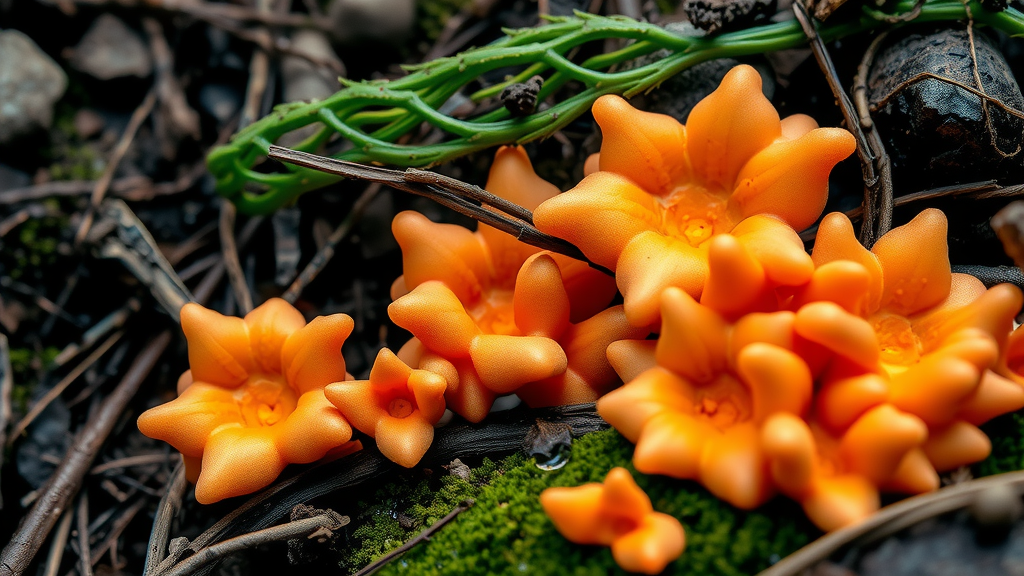These intriguing organisms are frequently relegated to the background in discussions surrounding biodiversity, yet they showcase remarkable characteristics. Myxomycetes, or slime molds, belong to the diverse kingdom of eukaryotes.
They exhibit both unicellular and multicellular forms, showcasing a unique versatility among protists.
Thriving in moist, shaded environments, slime molds play an important role in nutrient cycling within their ecosystems.
Unlike most fungi, these organisms can move and respond to environmental stimuli through their amoeboid forms. Their ability to communicate chemically enables them to coordinate movement and behavior in search of food, illustrating their impressive adaptability and various survival strategies.
Are Slime Molds Classified As Protists
The classification of certain organisms can reveal surprising insights into their biological nature. Slime molds are part of the diverse group known as protists, which encompasses various unicellular and multicellular organisms.
Specifically, they fall under the taxonomic group Myxomycetes, a classification frequently overlooked as many people mistakenly think of them only in relation to fungi.
Unlike fungi, these organisms can display multicellular behavior during their plasmodial stage, which allows for effective spore formation and nutrient distribution.
A notable feature of slime molds is cytoplasmic streaming, a process that enhances their ability to transport nutrients throughout their bodies. Their unique adaptations enable them to thrive in a range of environments, playing a vital role in nutrient cycling and decomposition within ecosystems.
Understanding Myxomycetes And Their Characteristics
This group of organisms possesses fascinating traits that blur the lines between fungi and protists. Myxomycetes display a complex life cycle characterized by the plasmodium stage, where they exhibit motility and actively seek decaying organic material to feed on.
During their development, they can form distinct fruiting bodies, which serve as structures for spore production.
These spores are remarkably resilient, capable of withstanding extreme environmental conditions, which enhances their role as decomposers within various ecosystems.
The thriving presence of these organisms in moist environments is instrumental in nutrient cycling, as they contribute to the breakdown of organic matter, sustaining soil health and supporting a wide range of life forms.
| Organism Type | Life Cycle Stage | Environmental Resilience | Ecological Role |
|---|---|---|---|
| Myxomycetes | Plasmodium | Capable of withstanding extreme conditions | Decomposers in nutrient cycling |
| Myxomycetes | Fruiting Bodies | Supports spore production | Contributes to soil health |
What Role Do Slime Molds Play In Ecosystems
These fascinating organisms significantly contribute to their natural surroundings, primarily through nutrient cycling. Acting as decomposers, they break down organic material, enriching the soil and fostering habitats conducive to plant growth and diverse microbial life.
This process is not merely beneficial; it is integral to ecosystem health, supporting various forms of life that depend on nutrient availability.
Slime molds also play a role in the distribution and population dynamics of bacteria, enhancing microbial diversity within their environments.
They serve as environmental indicators, often reflecting the presence of decaying organic matter and the overall state of their habitat. Their remarkable adaptability allows them to thrive in a variety of conditions, underscoring their importance in maintaining ecological balance.
As we move into exploring the life cycle of these organisms, it is essential to consider how their unique interactions within ecosystems further illustrate their ecological significance.
Life Cycle Of Slime Molds Explained
Examining the unique biology of these remarkable organisms reveals a complex life cycle marked by several intriguing stages. Initially, they exist as a plasmodium, which is a large cell exhibiting multiple nuclei.
This plasmodium is heterotrophic, allowing it to effectively move through its environment and engulf food sources such as bacteria, which facilitates rapid growth.
As changes in environmental conditions occur, these entities develop fruiting bodies designed for spore release.
Certain species can generate spore-filled structures that may rise several centimeters above ground, thereby enhancing spore dispersion across their habitats. Spores produced during this phase can enter dormancy for extended periods, sometimes lasting years, waiting for appropriate moisture and temperature to trigger germination.
Once conditions improve, spores metamorphose into myxamoebas. These myxamoebas have the capability to form complex structures that play significant roles in heterotrophic microbial ecology, influencing slime mold taxonomy and cellular organization within their ecological niches.
- The plasmodium stage is characterized by a large cell with multiple nuclei, facilitating efficient nutrient absorption.
- Fruiting bodies can elevate several centimeters above ground, improving spore dispersal in various environments.
- Spores can remain dormant for years, waiting for optimal conditions to germinate, showcasing resilience in their life cycle.
- Myxamoebas play a crucial role in microbial ecology, affecting slime mold classification and ecological organization.
Exploring Slime Mold Habitats And Adaptations
These fascinating organisms exhibit a remarkable ability to thrive across diverse ecosystems worldwide. They often favor moist habitats, such as forests, grasslands, and decaying wood, where they play an important role in nutrient absorption and contribute to the overall health of their surroundings.
The presence of organic matter and moisture levels significantly shapes their habitat preferences, allowing them to adapt effectively to varying conditions.
Temperature and humidity influence their growth patterns and activities, highlighting their sensitivity to environmental changes.
Slime molds can form plasmodia, which act as protective structures in adverse conditions, ensuring survival during less favorable times. They often engage in symbiotic relationships with soil organisms, reinforcing their function in promoting biodiversity and maintaining ecological balance.
This capacity for adaptability allows them to occupy a range of ecological niches, showcasing the complexity of their life cycles and reproductive strategies.
How Do Slime Molds Reproduce And Form Spores
The reproductive mechanisms of these fascinating organisms showcase a remarkable adaptability to their environment, incorporating a blend of both asexual and sexual strategies. Members of the myxogastria group can transition between these reproductive styles in response to varying conditions.
During asexual reproduction, specialized structures known as sporangia develop, facilitating spore formation.
These spores are released into the surroundings, where they can remain dormant for significant durations, ensuring their survival until environmental conditions become suitable for germination.
Conversely, sexual reproduction involves the formation of gametes within a plasmodium, where some species exhibit intricate mating types that contribute to genetic variability. The dispersal of spores is integral to ecological dynamics, supporting the colonization of new habitats.
As these organisms thrive in different environments, their role in nutrient cycling reflects their importance within ecosystems, leading to broader implications for ecological balance.
Myxogastria Reproductive Mechanisms
- Myxogastria can switch between asexual and sexual reproduction based on environmental conditions.
- Asexual reproduction involves the formation of sporangia, which produce spores that can remain dormant for extended periods.
- Sexual reproduction leads to the creation of gametes within a plasmodium, promoting genetic diversity among species.
- The dispersal of spores plays a crucial role in ecological dynamics and the colonization of new habitats.
The Significance Of Slime Molds In Nutrient Cycling
The role of these fascinating organisms extends far beyond mere decomposition in various ecosystems. They contribute to nutrient dynamics by breaking down organic materials, transforming them into accessible forms for other organisms.
This decomposition enhances the availability of nitrogen and phosphorus, which are important for plant growth.
During their vegetative state, slime molds can create large multicellular structures, which significantly boosts their efficiency in nutrient acquisition.
Their remarkable environmental adaptation allows them to shift their feeding strategies depending on nutrient levels present in their surroundings. This flexibility is instrumental in maintaining healthy microbial communities, thereby influencing nutrient cycling across diverse habitats.
Given their unique cellular communication capabilities, they also interact with surrounding organisms, fostering a balanced ecosystem. The insights gained from studying these organisms contribute significantly to understanding broader ecological processes and pave the way for further research advancements in slime mold taxonomy.
Research Advancements In Slime Mold Taxonomy
Recent developments have reshaped perceptions concerning the classification of these unique organisms within the broader spectrum of life. Advances in genomic techniques have unearthed new relationships among slime molds, prompting a re-evaluation of their taxonomy.
This ongoing research highlights the diverse reproductive strategies exhibited by these organisms, which significantly influence ecological interactions across various habitats.
The reassessment of slime molds underscores the fluidity of taxonomic categories, an aspect that holds critical implications for microbial communities.
As researchers delve deeper into their complex life cycles, the potential applications of slime molds in culture are being examined, particularly concerning sustainability and environmental management. Through these advancements, the role of slime molds in nutrient cycling and their contributions to ecological succession have become increasingly recognized in scientific discourse.
Slime Molds
- Advances in genomic techniques have revealed new relationships among slime molds, leading to a re-evaluation of their taxonomy.
- Slime molds exhibit diverse reproductive strategies that significantly influence ecological interactions across various habitats.
- Research highlights the fluidity of taxonomic categories, which has critical implications for understanding microbial communities.
- Slime molds play a vital role in nutrient cycling and contribute to ecological succession, emphasizing their importance in sustainability and environmental management.

